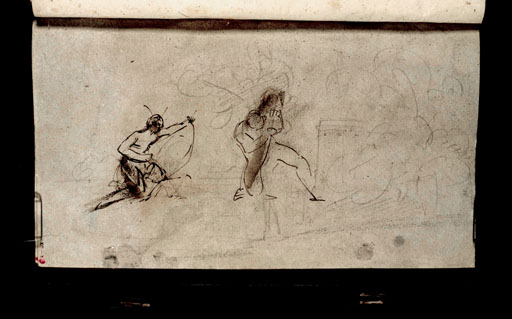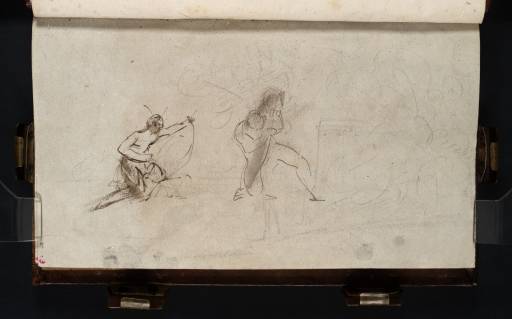Joseph Mallord William Turner Studies for 'Isis' and 'Apollo and Python': a Classical Rotunda by a River, and Two Studies of Apollo with a Bow 1805
Image 1 of 2
-
 Joseph Mallord William Turner, Studies for 'Isis' and 'Apollo and Python': a Classical Rotunda by a River, and Two Studies of Apollo with a Bow 1805
Joseph Mallord William Turner, Studies for 'Isis' and 'Apollo and Python': a Classical Rotunda by a River, and Two Studies of Apollo with a Bow 1805 -
 Joseph Mallord William Turner, Studies for 'Isis' and 'Apollo and Python': a Classical Rotunda by a River, and Two Studies of Apollo with a Bow 1805 (Enhanced image)Enhanced image
Joseph Mallord William Turner, Studies for 'Isis' and 'Apollo and Python': a Classical Rotunda by a River, and Two Studies of Apollo with a Bow 1805 (Enhanced image)Enhanced image
Joseph Mallord William Turner,
Studies for 'Isis' and 'Apollo and Python': a Classical Rotunda by a River, and Two Studies of Apollo with a Bow
1805
Joseph Mallord William Turner 1775–1851
Folio 3 Recto:
Studies for ‘Isis’ and ‘Apollo and Python’: a Classical Rotunda by a River, and Two Studies of Apollo with a Bow 1805
D05494
Turner Bequest XC 3
Turner Bequest XC 3
Pencil and pen and ink and wash on off-white wove paper, prepared with a grey wash, 150 x 258 mm
Inscribed by John Ruskin in red ink ‘3’ bottom left, descending vertically
Stamped in black ‘XC 3’ bottom left, descending vertically
Inscribed by John Ruskin in red ink ‘3’ bottom left, descending vertically
Stamped in black ‘XC 3’ bottom left, descending vertically
Accepted by the nation as part of the Turner Bequest 1856
References
1909
A.J. Finberg, A Complete Inventory of the Drawings of the Turner Bequest, London 1909, vol.I, p.234, XC 3, as ‘Studies for figure of Apollo with Bow’.
1974
Martin Butlin, Andrew Wilton and John Gage, Turner 1775–1851, exhibition catalogue, Royal Academy of Arts, London 1974, p.63.
1984
Martin Butlin and Evelyn Joll, The Paintings of J.M.W. Turner, revised ed., New Haven and London 1984, p.82.
1990
Andrew Wilton and Rosalind Mallord Turner, Painting and Poetry: Turner’s ‘Verse Book’ and his Work of 1804–1812, exhibition catalogue, Tate Gallery, London 1990, p.119.
1993
David Hill, Turner on the Thames: River Journeys in the Year 1805, New Haven and London 1993, p.160, as ‘Two studies of a figure with a bow ... [and] classical rotunda by the river’.
Finberg did not notice the faint pencil sketch underlying the figure studies, which Hill was the first to observe and identify. With further sketches of the same subject on folios 4, 5, 6, 9, 29 and 31 (D05495, D05496, D05497, D05502, D05531, D05535) this anticipates the composition of Turner’s painting of 1807–10 bought by the Earl of Egremont, known as The Thames at Weybridge (Tate T03872; displayed at Petworth House)1 but engraved as Isis for the Liber Studiorum.
Following early commentators on the Liber, Finberg associated most of the related drawings in this sketchbook, beginning with folio 4 (D05495), with a ‘Temple of Isis’ in Petworth Park, but the Ionic rotunda at Petworth is situated on a hill some way from the lake. Neither the Weybridge nor the Petworth locations are accepted today and this sketchbook indicates a position by the Thames. Some of the drawings incorporate views south-west from Kew, with the Dutch House (now Kew Palace), and the site must have been very close to Turner’s home at Sion (or Syon) Ferry House. Evidently the same rotunda appears in Isleworth, another Liber plate (for the drawing see Tate D08163; Vaughan Bequest CXVIII I). Edward Croft-Murray, in marginal comments in a copy of Finberg in the Tate Library, suggested ‘?Sion boathouse’ and Wilton identifies it as the Alcove, which he describes as the Duke of Northumberland’s waterside shooting lodge. It is likely to be inspired by the Pavilion built for the Duke by Robert Mylne and completed in 1803, its identity obscured in some of Turner’s sketches by his omission of its flanking wings to give it more of the appearance of a classical temple. The wings are shown in the sketch on folio 27 (D05528), viewed from the river at the Isleworth corner of Syon Park. Probably it appears again, with Isleworth church behind it, on folio 53 (D05574). For further discussion see notes to the drawing for Isis (Tate D08168; Vaughan Bequest CXVIII N).
Verso:
Blank
David Blayney Brown
August 2007
How to cite
David Blayney Brown, ‘Studies for ‘Isis’ and ‘Apollo and Python’: a Classical Rotunda by a River, and Two Studies of Apollo with a Bow 1805 by Joseph Mallord William Turner’, catalogue entry, August 2007, in David Blayney Brown (ed.), J.M.W. Turner: Sketchbooks, Drawings and Watercolours, Tate Research Publication, December 2012, https://www

